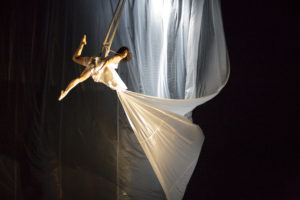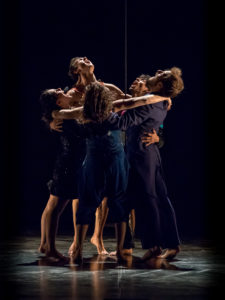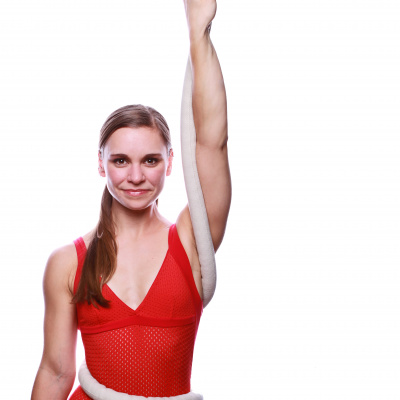Raphaëlle Boitel Describes Fierce 5: It Wakes Up Something
Sometime in early April, I went through my Google calendar deleting, well, everything. I found myself thinking that it was the opposite of a Marie Kondo purge. I was discarding everything that sparked joy for me: rehearsals, teaching, outings with friends, shows I was meant to see. One of those shows was Fierce 5 by Raphaëlle Boitel, choreographer and director of L’Oublié(e). Raphaëlle and I spoke back in February about the show, her company and what she believes contemporary circus brings to audiences.
Raphaëlle Boitel: My story — there is many things about it — it would be a bit long to tell you everything… I trained at the Fratellini school in Paris. Annie Fratellini was the first female clown; she’s an important woman, and she did a lot for me. She invited me to come to Paris and to go to the circus school. This is a long story, a bohemian story. With all my family, we came to Paris in a truck. My mother just left everything in the south of France, and we went to the capital. We came for circus with no money, with nothing, just passion. My mother always taught me that everything is possible, but you have to work for it. All my life is around this kind of proverb… I worked with James Thierrée, the grandson of Charlie Chaplin, when I was very young, 13 years old.
This is a long story, a bohemian story. With all my family, we came to Paris in a truck.
Madeline Hoak: What is the story behind the name of your company, L’Oublié(e)?
RB: Yes, The Forgotten, in English. It’s the name of my first show. It took me maybe ten years from the moment of the first idea and when I actually did it. But I was very young, so that was okay. I was maybe 19 when I wanted to do it, then I had to create my company and all of that. The show changed a lot, but at the beginning, I was working on [the idea of] important women that had been forgotten by the people. L’Oublié(e) could be one of these women — a missing person that kind of disappeared and died, but I didn’t say it like this. In the show, a man was [in] conscious of the woman. We see her getting old and she goes and tries to look for him in the other world… So it could also be this man that is forgotten — it’s her, it’s him. The title, I dreamt it, and I forced myself to wake up and write it down.

What I do today with my different shows is really mixing the disciplines. I really like to work with a group. I work with opera sometimes for dance or for circus. What really interests me is to talk with the body, but always for something, for an important reason. It’s not just movement for movement or performance for performance (even if I love performance obviously, I put it when I can in my shows), but what is most important for me is what we’re talking about and the effects it can have on the audience.
The new circus in France is such a good way to be gathered around something that is joyful, beautiful, impressive, but we can talk about very deep subjects, also. What I keep most is this state of mind of being familial and human between each other. When we create dreams it’s important to be a good human being. So we try our best.
MH: What is Fierce 5 about for you?
RB: It’s an homage to circus. I really have a lot of love for circus. I really wanted to talk about the perseverance in life that you need to be able to go into your own goals.
What really interests me is to talk with the body, but always for something, for an important reason.
To do the crazy stuff we are doing in circus, it needs a lot of [physical] strength and also mental strength. I experience perseverance every day. In this particular show, I was so fascinated by how each one of these artists train every day and have a special relationship with their apparatus. Every day you do the same movements, you touch your apparatus, and you have a relationship that is quite complicated. There is a lot of contradiction in the relation[ship] to it. It makes you do some amazing beautiful things, but it’s painful, physically… I also wanted to talk about the people. There are five people [in the show] and they all come from different countries, and they all are gathered together for a common goal. The show talks about solidarity, how it’s important to help each other, to be together. It’s beautiful to have those same goals in an artistic work. And then of course the virtuosity of circus: how a normal person can do the impossible, and how everything is possible if you work hard.
This show is really my love for circus; it’s funny and it’s sad. One of the first scenes is a young boy that is trying the high wire. The kids [in the audience] laugh so much because he is just trying to stand on the wire. It’s acrobatic clowning, but it really talks about the depths of the show. In life you are a bit on the wire, you walk, and you fall and fall again. How do you learn to stand, just your foot on the wire? It’s a comical way to talk about life, the feeling of équilibre and how you learn from your fall, which is interesting. Because we fall, always.
We had one dancer/contortionist/acrobat who did not have an apparatus. That was a problem for the subject of my show. We looked for the apparatus for her. We looked for a long time to find the right one, and it’s the best one, in a way.

We created a new apparatus; it’s kind of the climax of the show. It’s a three-dimensional aerial scene, very beautiful, that is very meaningful. It’s kind of a storm, a beautiful storm. When you create a new apparatus it’s a long research [period] of finding the best way to use it. Then, of course, it’s always complicated to think how you attach the apparatus and how you take it out. How do you make it meaningful, not just a technical exchange
There are five circus performers and two technicians. The technicians are on stage and are really choreographed by me to music. They are constructing this world around them [the cast]. The technique is choreographed, and the technique, I think, is so beautiful. Those gestures are choreographic if you just put a focus on it.
It is a really open story, but we understand that they are together, creating. It’s like the background [behind the scenes], rehearsals, and in this way it’s a very contemporary way to do circus. I also wanted to talk about our origins. The costumes you see at the end, they are the original costumes of Fratellini. I didn’t want to forget our past, we come from these people.
I always have the same composer… In this show, I also used classical music because I wanted to put the classical instruments, the virtuosity of the classical musician with the circus performer. So there is very dynamic and joyful music that really works with the movement, and then we have one music that is kind of rock and roll and it’s a funny moment crazy. So it’s maybe less– it’s a bit lighter than When Angles Fall, in a way it’s not. A dystopia but it may be more of a utopia than a dystopia– but with still strong emotions and difficult moments also like in all my shows.
MH: You already spoke about perseverance, but what do you hope the audience walks away with?

RB: Hope, beauty, poetry in their minds. The feeling of being human, and that you can be together and look at each other and say, ‘We can help each other.’ At the New Vic [theater in NYC], we do a lot for kids and families, and it’s so important for kids today to learn how to be with each other and not be so individual. Hope, joy and hope of ‘We can do better.’ Even if the world is going very wrong, how you learn to do better. And to do better is to look at each other and be even more awake. Art is so important, it really wakes up our dreams and our ennui. Sometimes we forget everything with our screen and listening to everyone, ‘Ok you have to do this and do this.’ But shows like this can help everyone be more awake, and leave with a feeling of hope. It wakes up something.
A Note from Raphaëlle Boitel about company activities since mid-March:
On March 14th, we had to cancel the premiere of my first play for young audiences, Un Contre Un, in Angoulême. On the 16th, we had to go home and stay, like everyone else in France. Suddenly a lot of dreams vanished. That day, the New Victory Theater (New York City) announced they had to cancel the three weeks of Fierce Five. It was a real shock and a huge disappointment for all of us!
We had forty-two cancelled performances of three different shows from the Company’s repertoire from March to June, 2020.
First, we had to manage the crisis in order to maintain the financial stability of the company and our employees — which is not easy, and a real disaster for us and the cultural world if the theaters don’t open again soon!
Then, I needed to keep dreaming.
In May and June, we went to theaters in residence to start the creation of the new projects. In July, I kept in touch with young American citizens by giving a virtual workshop with FIAF in Montclair, NJ. On August 1st, we performed Un Contre Un live streaming for children in hospitals.
We are currently working on different possibilities and projects.
My connection to cinema is growing every day, and maybe this strange time is accelerating it. Cinema has always inspired my work, and now I want to create a link by making fiction or presenting our shows reshaped for a cinematographic format with the highest standards.
Although, I think in this context, we should be very careful not to get used to seeing all the arts by video or on screens. This tool should not be the only means of dissemination. We must imperatively preserve the world of the performing arts, which I believe is the most precious thing; it is the direct and sensory link, the meeting and sharing with the public, that transmits the strongest emotions.
I will never give up live performance! Let’s fight for it!
Related Content: When Angels Fall –French Devised Performance with Circus at Its Core Inspiring US Audiences, A Mix Of Circus And Dance, ‘When Angels Fall’ Imagines A Dystopia That Pits Humanity Against Technology, Contemporary Circus Programming at Montclair State Aims to Defy Expectations of Virtuosity
Featured Image: Raphaëlle Boitel. Photo by Louis Michel Grevent....
Do you have a story to share? Submit your news story, article or press release.



